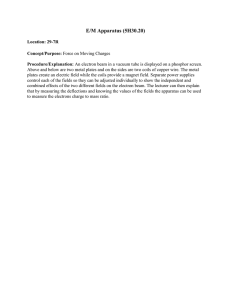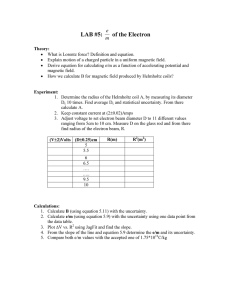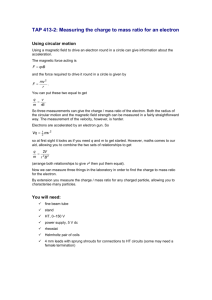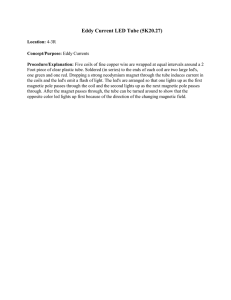Exp1: Charge to Mass Ratio of the Electron
advertisement
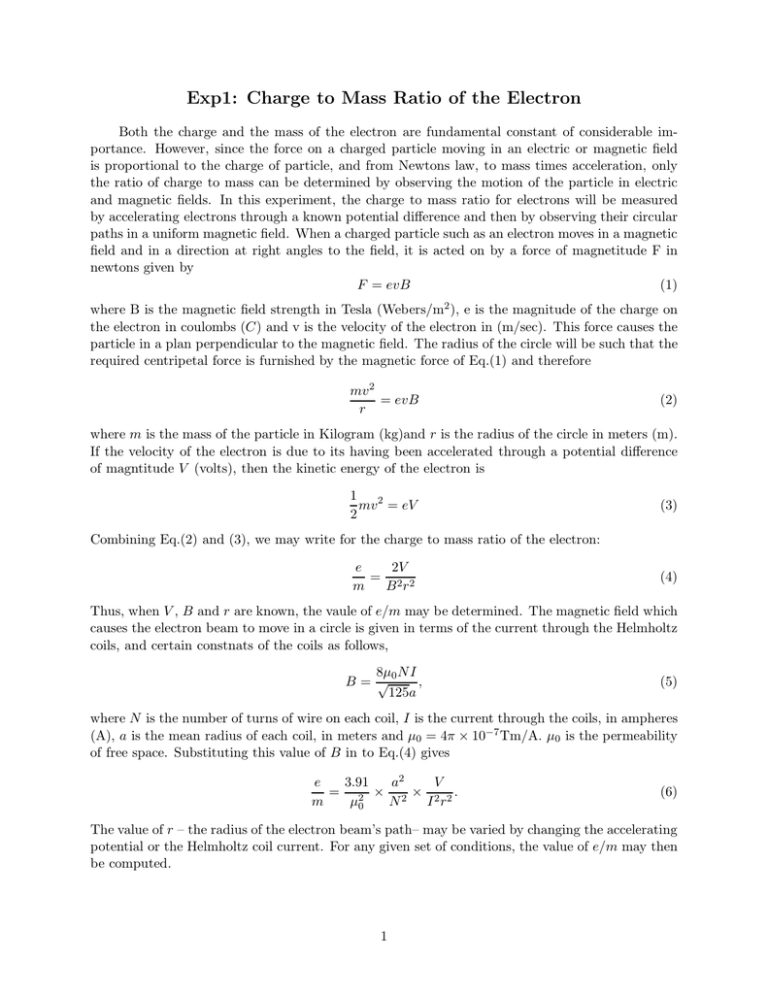
Exp1: Charge to Mass Ratio of the Electron Both the charge and the mass of the electron are fundamental constant of considerable importance. However, since the force on a charged particle moving in an electric or magnetic field is proportional to the charge of particle, and from Newtons law, to mass times acceleration, only the ratio of charge to mass can be determined by observing the motion of the particle in electric and magnetic fields. In this experiment, the charge to mass ratio for electrons will be measured by accelerating electrons through a known potential difference and then by observing their circular paths in a uniform magnetic field. When a charged particle such as an electron moves in a magnetic field and in a direction at right angles to the field, it is acted on by a force of magnetitude F in newtons given by F = evB (1) where B is the magnetic field strength in Tesla (Webers/m2 ), e is the magnitude of the charge on the electron in coulombs (C) and v is the velocity of the electron in (m/sec). This force causes the particle in a plan perpendicular to the magnetic field. The radius of the circle will be such that the required centripetal force is furnished by the magnetic force of Eq.(1) and therefore mv 2 = evB r (2) where m is the mass of the particle in Kilogram (kg)and r is the radius of the circle in meters (m). If the velocity of the electron is due to its having been accelerated through a potential difference of magntitude V (volts), then the kinetic energy of the electron is 1 mv 2 = eV 2 (3) Combining Eq.(2) and (3), we may write for the charge to mass ratio of the electron: e 2V = 2 2 m B r (4) Thus, when V , B and r are known, the vaule of e/m may be determined. The magnetic field which causes the electron beam to move in a circle is given in terms of the current through the Helmholtz coils, and certain constnats of the coils as follows, 8µ0 N I , B= √ 125a (5) where N is the number of turns of wire on each coil, I is the current through the coils, in ampheres (A), a is the mean radius of each coil, in meters and µ0 = 4π × 10−7 Tm/A. µ0 is the permeability of free space. Substituting this value of B in to Eq.(4) gives a2 e 3.91 V = 2 × 2 × 2 2. m N I r µ0 (6) The value of r – the radius of the electron beam’s path– may be varied by changing the accelerating potential or the Helmholtz coil current. For any given set of conditions, the value of e/m may then be computed. 1 Figure 1: The e/m tube. (a) Schematic diagram of the e/m tube, looking in the direction opposite to the magnetic field. (b)Side view of accelerating electrodes and cross bars. Figure 2: Circuit diagram for powering the e/m tube. Note that the protective resistance must be placed in the positie leg of the circuit in order to obtained correct data. Figure 3: Wiring diagram for the Helmholtz coils 2 Procedure 1. The axis of the Helmholtz coils must first be arranged so that the effect of the earth’s field can be cancelled. Orient the Helmholtz coils so that the e/m tube will have its long axis in a magnetic north-south direction, as determined by compass. Measure the magnetic inclination at this location with a dip needle. Tip the coils up until the axis is parallel to the earth’s magnetic field. 2. Check that the electrical connections to the tube and coils are as shown in Figure 2. To prolong the life of the tube, the power supplies should be turned on in the following order ( and turned off in reverse order): (a) Turn on the anode power supply and apply 40 volts accelerating potential to the tube. (b) With the filament power supply voltage dial set to zero, switch on the filament supply and slowly increase its voltage until the beam becomes visible. The room lights may have to be turned off to see the beam The electron beam should be deflected slightly toward the base of the tube by the Earth’s magnetic field. The filament of the e/m tube has the proper electron emission when carrying current from 3.5 to 4.5 amperes. DO NOT exceed 4.5 A, as the life of the tube will be materially shortened. Best results are usually obtained by keeping the filament current low – that is, no higher than necessary to make the beam visible. (c) Turn on the power supply for the Helmholtz coils and adjust the value of the current until the electron beam is straight One way to do this is to adjust the beam until it is aligned with a straightedge that is placed above the beam such that one is looking down on the beam along on side of the straightedge. This adjustment should be made carefully and at the lowest accelerating potential (why?) When the beam is straight, the magnetic field of the coils just cancels the Earth’s magnetic field. Record this value of the current as I0 , the initial current. Three independent determinations of I0 , should be made as it is somewhat difficult to judge exactly when the beam is undeflected. From the three measurement I0 , determine the best value of I0 and estimate its uncertainty. (d) The magnitude of current that bends the beam into a full circle, herein called, Itotal , will contain the initial current I0 that corrects the beam for the Earth’s field. Therefor, I0 will be subtracted from Itotal to obtain the corrected current, Inet to be used in Eq.(6). That is Inet = Itotal − I0 . (e) Increase the field current until the electron beam describes a circle. Adjust the current until the sharp outside edge of the beam strikes the inside edge of the outermost crossbar. Record this values as Itotal . The outside edge of the beam is used because it is defined by the electrons with the greatest velocity; the electrons leaving the negative end of the filament fall through the greatest potential difference that the voltmeter measures. (f) Determine and record the field currents required to cuase the electron beam to similarly strike the four remaining bars in the set of 5. Subtract I0 from the each current Itotal , and record as the corrected current Inet . These five currents will be the values used in Eq.(6). Now find and record appropriate values for the field current Inet for 60 and then 80 volt for anode power supply. This should give a data set consisting of 15 values of Inet – five cross bar diameters ( remember to convert to radii) and three voltages. The diameters from the filament to the inside of the crossbar are given in Table 1. In measuring electron beam diameters, be aware that the experimental uncertainty in 3 crossbar 1 2 3 4 5 Tube #1 (unit: cm) 6.33 ± 0.07 7.54 ± 0.07 8.77 ± 0.07 9.98 ± 0.07 11.22 ± 0.07 Tube #2 (unit: cm) 6.39 ± 0.07 7.69 ± 0.07 9.12 ± 0.07 10.27 ± 0.07 11.46 ± 0.07 Table 1: Distance in centimeter (cm) from the filament to the inside of the crossbars (Note that these are diameter, not radii. diameter is typically much greater than that implied by the uncertainty, δd, given in Table 1.The number of turns, N in each coil is 72. The radius of the Helmholtz coils a should be determined with a meter stick. The finite width of the coil themselves must somehow be included in this measurement. (g) Compute e/m for each of the 15 data sets thus obtained. The average value of e/m should be determined from your complete set of measurements, along with the standard deviation and the standard error of mean. The latter number can serve as a measure of the random error in the experiment. In this experiment, systematic errors can be important. Take note of the systematic errors in the ammeter and voltmeter. There are also systematic errors in a and r. 3. The systematic error in your value of e/m should be calculated for one representative set of data. The random and systematic errors should the be added in quadrature. Your final value of e/m along with its calculated uncertainty should be compared with the accepted value of 1.759 × 1011 C/kg. 4. You may want to examine your results to see if your values of e/m show any systematic dependence on any of quantities in Eq.(6). Such a systematic dependence can result from, for instance, an incorrect value for I0 . 4
